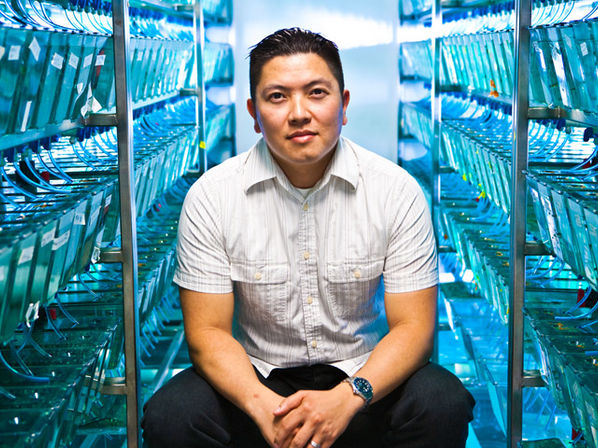Incurable liver disease may prove curable
Research has found a drug that can spur liver regeneration in Alagille syndrome: researcher taking Steps to form a start-up company
Research led by Associate Professor Duc Dong, Ph.D., has shown for the first time that the effects of Alagille syndrome, an incurable genetic disorder that affects the liver, could be reversed with a single drug. The study, published in the Proceedings of the National Academy of Sciences, has the potential to transform treatment for this rare disease and may also have implications for more common diseases.

Duc Dong, Ph.D.
Sanford Burnham Prebys
“Alagille syndrome is widely considered an incurable disease, but we believe we’re on the way to changing that,” says Dong, who is also the associate dean of admissions for Sanford Burnham Prebys’ graduate school. “We aim to advance this drug into clinical trials, and our results demonstrate its effectiveness for the first time.”
More than 4,000 babies each year are born with Alagille syndrome, which is caused by a mutation that prevents the formation and regeneration of bile ducts in the liver. Children with Alagille syndrome frequently require a liver transplant, but donor livers are limited, and not all children with Alagille syndrome qualify. Without a transplant, the disease has a 75% mortality rate by late adolescence.
“Duc and his team continue to do thrilling research on Alagille syndrome, and these breakthroughs certainly offer hope for families living with this very complicated and complex disorder,” says Roberta Smith, CNMT, president of the Alagille Syndrome Alliance. “We have been longtime supporters of Duc's work and have come to know him as a driven, dedicated scientist who is passionate about moving the needle one step closer toward a cure.”
Their new drug, called NoRA1, activates the Notch pathway, a cell-to-cell signaling system present in nearly all animals. Notch signaling helps orchestrate fundamental biological processes and plays a role in many diseases in addition to Alagille syndrome. In children with Alagille syndrome, a genetic mutation causes a reduction in Notch signaling, which results in poor liver duct growth and regeneration.
The researchers found that in animals with mutations in the same gene affected in Alagille syndrome, NoRA1 increases Notch signaling and triggers duct cells to regenerate and repopulate in the liver, reversing liver damage and increasing survival.
“The liver is well known for its great capacity to regenerate, but this doesn’t happen in most children with Alagille syndrome because of compromised Notch signaling,” says first author Chengjian Zhao, a postdoctoral researcher in Dong’s lab. “Our research suggests that nudging the Notch pathway up with a drug could be enough to restore the liver’s normal regenerative potential.”
The researchers are currently testing the drug on miniature livers cultured in the lab with stem cells derived from the cells of Alagille patients.
“Instead of forcing the cells to do something unusual, we are just encouraging a natural regenerative process to occur, so I’m optimistic that this will be an effective therapeutic for Alagille syndrome,” adds Dong.
Dong is also taking steps to form a start-up company to drive this drug toward clinical trials. The new company will initially focus on Alagille syndrome, but also plans to develop this drug for other, more prevalent diseases, including certain cancers.
Original publication
Other news from the department science
Most read news
More news from our other portals
Something is happening in the life science industry ...
This is what true pioneering spirit looks like: Plenty of innovative start-ups are bringing fresh ideas, lifeblood and entrepreneurial spirit to change tomorrow's world for the better. Immerse yourself in the world of these young companies and take the opportunity to get in touch with the founders.























































